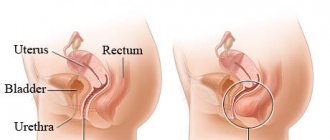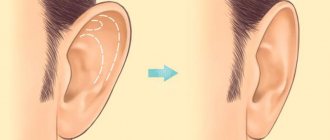How to do a caesarean section
Childbirth is a natural process for women, and their body is fully adapted to it. But it also happens that for some reason a woman cannot give birth naturally, since this will endanger not only her life, but also the life of the unborn child.
It is in such circumstances that a caesarean section is performed.
How is a caesarean section performed?
How is a caesarean section performed, and at what stage of pregnancy is such an operation usually performed?
Your doctor will set a date for surgery based on the health and condition of the mother and her baby. If there are no complications or any special indications, then the date will be set for the planned day of birth. It is possible that the operation may take place on the day the expectant mother’s contractions begin.
How to prepare for future births?
Before labor begins via cesarean section, the woman is hospitalized so that the doctor can monitor the condition of both the woman and the child. Typically, a cesarean operation is performed in the morning. During surgery, the mother's stomach must be empty. All this is to ensure that food debris does not enter the woman’s respiratory tract.
In the morning, before the operation itself, the woman in labor is given hygienic procedures (the pubis is shaved, an enema is given). After this, the expectant mother is put on a special shirt, and the woman is taken to the operating room.
Before the operation itself, a catheter is inserted into the bladder, anesthesia is given, and the stomach is disinfected with a special agent. After this, a screen is installed in the area of the woman’s chest, which is designed to prevent the woman in labor from seeing the progress of the operation.
Caesarean section is not performed without anesthesia.
Today, doctors use two types of anesthesia: general anesthesia and epidural. The second involves the introduction of the drug into the epidural space of the spine. And although this sounds scary, unpleasant sensations will accompany the woman for only a couple of seconds - during a puncture. After such anesthesia, the woman ceases to experience any sensations in the lower part of the body.
General anesthesia is used only if anesthesia is needed urgently and there is absolutely no time to wait for the epidural to take effect.
And, directly, how is a caesarean section performed, and how does the operation itself take place?
Immediately after the anesthesia has begun to take effect, the operation itself begins.
The doctor will first make a small incision in the abdominal wall. After this, the surgeon spreads the muscles, makes a small incision in the uterus and opens the amniotic sac. Then the birth occurs by cesarean section - the doctor removes the child. After this, the placenta is also removed.
After the birth is over, the doctor stitches up the incision on the uterus and abdominal wall. The surgeon will apply a sterile dressing.
After giving birth, the mother enters a period called “post-operative.”
For at least a day after giving birth, the mother is now in the intensive care unit. After this, the woman will be transferred to a regular ward. The doctor will prescribe painkillers to reduce the pain that will occur after surgery. Medicines will also be prescribed to contract the uterus, as well as to normalize the functioning of the gastrointestinal tract.
If the operation was successful, the woman will be allowed to stand up after at least 6 hours. To begin with, it is best to just sit on the couch, and then stand for a while. Under no circumstances should you strain; in the worst case, you can expect the seams to rip apart.
Postoperative “behavior” of a woman.
It is worth remembering that while you are in the hospital, a nurse will be looking after you. But once you are discharged, you will be responsible for caring for your baby as well as your own health. So, what kind of care and nutrition should you and your baby have?
You should drink a lot in the first days after surgery. All this is to replenish the fluid that you lost during childbirth. Doctors believe that a full bladder is an obstacle to good uterine contractions. Therefore, try to empty it on time.
On the second day, your doctor may allow you to eat liquid foods. And from the third day, if everything goes well, you may be allowed to return to your usual diet.
After you are discharged from the maternity hospital, for about a month and a half you will absolutely not be allowed to take a bath, swim in pools, etc. Try to bathe in the shower.
Postpone physical activity for about 2-3 months. However, you shouldn’t give up exercise completely. Your doctor will need to advise you on some exercises that will help your body recover.
As for sexual life, it is also advisable to postpone it for a period of at least one and a half months. You should take care of protection. Doctors do not advise planning a pregnancy earlier than 2 years after such a birth.
Caesarean section: how to remove the belly
Probably, most women after giving birth by cesarean section are concerned about the question: how to get a flat tummy back? In order to achieve the desired result, you need to follow 8 rules.
- It will be possible to start classes and physical exercise only after 2 months after giving birth. It is best to start with regular walking. Because physical activity should be increased gradually.
- Walking with your baby can benefit not only your baby, but also you. For example, a brisk walk can gradually bring your figure into shape.
- If you have received the long-awaited answer from the doctor regarding physical activity, and it is positive, then we advise you to start exercising with ordinary bends. Don’t try to start pumping up your abs right away. Better wait a little longer.
- A child is a great helper in terms of losing weight. In a normal game with it, you can easily lose several kilograms.
- Abdominal retraction exercises are a very effective method. After a caesarean section, this will help you get rid of your belly fat.
- Perhaps the most important “exercise” for your figure is proper nutrition. It is best to contact a nutritionist who will create the right diet for you.
- For a woman who doesn’t really like physical activity, bodyflex is perfect. This is a system that includes stretching exercises and works with proper breathing. Today this method is quite popular and effective.
- Well, the last method is abdominoplasty. This method is great for those who want to trim their tummy after a cesarean section, but don't want to do any physical exercise. Actually, this is not a cheap surgical intervention. Doctors remove excess skin as well as fat deposits.
On the Internet you can find many videos on performing a caesarean section. To do this, you should enter “how to do a caesarean section video” in a search engine. And remember that with regular self-care you can get rid of your belly fat in a short period of time.
C-section
Indications for caesarean section
As a rule, a caesarean section is resorted to if the pregnancy proceeds with complications, and natural childbirth may pose some risks to the health of the mother and the unborn baby.
Currently, the age of first-time mothers has increased and, therefore, a woman aged, for example, 35 years old has more chronic and concomitant diseases than a 20-year-old woman.
If, during pregnancy registration, diseases are revealed that can negatively affect childbirth, then the patient undergoes a planned cesarean section .
If complications arise during childbirth that can harm the baby and mother during natural delivery, then an emergency caesarean section .
In our pregnancy clinic, we see mainly women who managed to become pregnant using ART methods (Insemination, stimulation, IVF, Donation), these are women with endocrine pathology and in the older age group.
It is the obstetrician-gynecologist who weighs all the risks of natural childbirth. Pregnancies in our patients are very long-awaited. But if there are no indications for cesarean section delivery, then it is better to give birth on your own.
A planned caesarean section may be prescribed to you by your doctor if the following indications exist:
- anatomically narrow structure of the pelvis, through which the baby’s head cannot pass;
- placenta previa is a condition in which the placenta blocks the exit from the uterus;
- pronounced gestosis;
- tumor formations of the pelvic organs, which can also prevent the birth of a child naturally;
- genital herpes in the active stage;
- a large scar on the uterus formed after previous surgical interventions;
- transverse position of the fetus;
- large fruit;
- the presence of certain diseases in the expectant mother: myopia, diseases of the cardiovascular system, etc.;
- age over thirty years in combination with other obstetric factors that can interfere with the natural process of childbirth;
- past infertility;
- pregnancy occurred after in vitro fertilization.
When concluding a contract for childbirth, the doctor will calculate the timing of delivery. The day before the expected birth, you will be hospitalized, after hygiene procedures and a cleansing enema, you will be transported to the operating room. Compression stockings should be worn before surgery.
An emergency caesarean section should be performed if any complications occur during natural childbirth that could threaten the health of the fetus and the woman in labor. This may be weakness of labor, placenta previa with bleeding, risk of uterine rupture, oxygen starvation of the fetus, etc.
Carrying out a cesarean operation
Performing a caesarean section falls on the shoulders of a medical team, which includes an obstetrician-gynecologist, a physician assistant, an anesthesiologist, a pediatric neonatologist, and operating nurses. Planned and emergency operations have fundamentally different approaches. A planned operation is performed according to a pre-planned algorithm, and an emergency caesarean section is performed if, due to complications during childbirth, it is necessary to urgently deliver a woman in labor. The main differences between elective and emergency caesarean section are:
- Most often, during a planned operation, epidural anesthesia is used so that the mother can immediately see the newborn;
- in emergency situations, as a rule, doctors use general anesthesia, since the woman may continue to have contractions that will prevent an accurate injection into the spinal canal;
- During planned operations, the surgeon always makes a transverse incision, while in emergency cases, sometimes it is necessary to make a longitudinal one in order to get the child out as quickly as possible.
After the baby is removed from the uterus, doctors remove the placenta and then apply stitches. The woman in labor is given an IV with a medicine that helps the uterus contract. Typically, a caesarean section lasts about forty minutes from the moment of the incision to the application of the last stitches.
The first day after the operation, the woman remains under the supervision of doctors in the intensive care unit. She is prescribed painkillers, constantly monitors her general condition, blood pressure and pulse, discharge from the genital tract, and monitors uterine contractions. After just six hours you are allowed to get up, and on the second day you can walk and start breastfeeding. An ultrasound and a number of tests are required. If everything is normal, you will be discharged within a week.
Anesthesia for caesarean section
A caesarean section can be performed using one of the existing types of anesthesia. As a rule, when preparing for a planned operation, you will be able to choose the appropriate method of pain relief after consultation with your doctor. Today, during a caesarean section, the following methods of pain relief can be used:
- endotrachial anesthesia is a drug-induced sleep into which a woman in labor is immersed when a gas mixture is administered through a tube inserted into the respiratory tract. This method of pain relief works quickly, however, recovery from it is more difficult. Nausea, vomiting, and drowsiness may occur;
- epidural anesthesia - pain relief is provided by injection of a special agent into the spinal canal, while only the lower half of the body loses sensitivity. By choosing this method of pain relief, you will remain conscious and will be able to see and hear everything that is happening in the operating room.
It is worth noting that both methods of pain relief carry certain risks for the child, which your doctor will definitely warn you about. The choice of anesthesia method is discussed with the woman in labor in advance, during a consultation with an anesthesiologist.
Recovery period after cesarean section
After a caesarean section, it will take about eight weeks for your body to fully recover. However, during the first four months you will have to refrain from physical activity and sexual contact. Also, in the first weeks after surgery, it is necessary to treat the sutures on the skin of the abdomen. If the postoperative period progresses well, you and your baby may be discharged home.
As a rule, after discharge from the maternity hospital, you will have an appointment with a doctor so that he can evaluate the healing process of the stitches and the restoration of your body. You will also be advised a special diet if you are breastfeeding.











